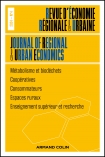
Revue d'économie régionale et urbaine (2/2023)
Pour acheter ce numéro, contactez-nous
Recevez les numéros de l'année en cours et accédez à l'intégralité des articles en ligne.
L’objectif de ce travail est d’étudier le comportement résidentiel des retraités en s’intéressant aux types de logement qu’ils consomment. Cet article montre dans un premier temps comment les attributs individuels et le passage à la retraite influencent les choix de logement. Dans un second temps, il explore les différences de comportement résidentiel entre les retraités et examine l’influence d’une mobilité entreprise durant la retraite sur les choix de logement. Les estimations de modèles probit mettent en évidence des différences significatives entre les logements occupés par les retraités et les non-retraités d’une part et entre retraités mobiles et non mobiles d’autre part.
The aim of this paper is to study the housing characteristics and the location preferences of the elderly in France. The paper first analyzes how individual characteristics impact the type and the location of occupied dwellings. Second, it explores the differences in the residential behavior between retirees and examines the influence of residential mobility during retirement. This work builds upon a dataset from the 2017 Insee French population census, which provides information on 28.551 million French inhabitants including 8.407 million retirees. By studying how personal attributes affect housing choices, through a series of empirical models, the paper delivers evidence that retirees behave differently than the rest of the population. Retirees tend to occupy larger and older houses, are more likely to live in urban areas and in individual houses rather than in apartments. The paper also shows a difference in behavior between young (less than 80 years old) and older retirees (80 and above). All retirees feature a higher probability to live or to settle in a city, but this probability is clearly higher for those aged above 80. The latter are also more likely to live in apartments as opposed to young retirees. Finally, the results of the probit models highlight the differences in housing between mobile retirees and non-mobile retirees, thus assessing the real preferences of this population when they decide to move. Mobile retirees occupy often new dwellings in urban areas. The former socio-professional category is also a key element of analysis for understanding disparities in housing choices of the retirees.
